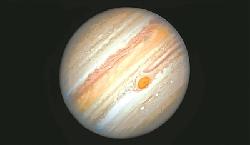Smaller storms might be fueling Jupiter's Great Red Spot
Title: Smaller Storms Could Be Fueling Jupiter's Great Red Spot Description: The discovery suggests that the enormous storm known as Jupiter's Great Red Spot might be sustained by the energy from smaller surrounding storms. According to recent research, these minor storms could play a significant role in maintaining the power and longevity of this massive Jovian weather system.

This study was featured in the most recent edition of the journal Icarus.
Situated in the southern hemisphere of Jupiter, the Great Red Spot is characterized by a giant red-orange oval of high-pressure air, spanning over 16,000 kilometers across. Historical observations reveal that the storm has been steadily reducing in size for the last century, with notable shrinkage occurring over the last five decades.
Although the latitudinal size of the storm has remained fairly stable, its longitudinal dimension has decreased substantially, from 40 degrees in the late 1800s to 14 degrees by 2016.
The research, conducted by scientists from Yale University and the University of Louisville, examined how smaller, fleeting storms affect the Great Red Spot.
Utilizing the Explicit Planetary Isentropic-Coordinate (EPIC) model, an atmospheric simulation tool developed in the 1990s by co-author Timothy Dowling of the University of Louisville, the team performed a range of 3D modeling experiments. These included simulations where the Great Red Spot interacted with various short-lived storms, as well as control simulations where these interactions were not included.
The results from these simulations indicated that the interactions with smaller storms actually contribute to the growth and maintenance of the Great Red Spot. In scenarios where these storms were absent, the research found that the Great Red Spot would diminish significantly in just 950 days.
Ian Smith for TROIB News
Discover more Science and Technology news updates in TROIB Sci-Tech












